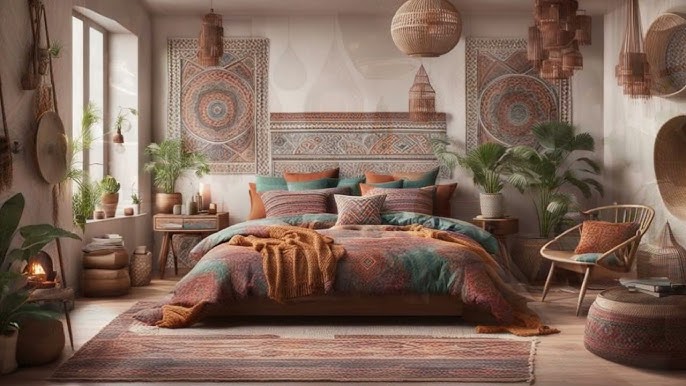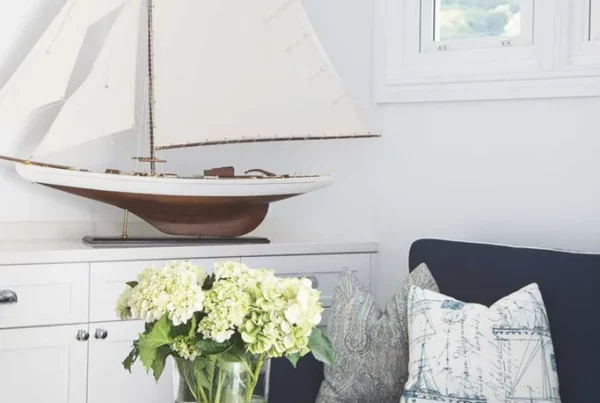Creating a calming and inviting home environment is essential for promoting relaxation and well-being. This article offers practical techniques for enhancing the ambiance of your space through effective textile layering, thoughtful use of natural elements, and strategic lighting solutions. By implementing these strategies, you can transform your home into a serene sanctuary, making it more comfortable and aesthetically pleasing.
In the following sections, you’ll learn how to incorporate textures, colors, and lighting techniques that not only improve the visual appeal of your space but also foster a tranquil atmosphere. These adjustments can significantly enhance your living experience, providing a retreat from the stresses of daily life.
Table of Contents
Layering Textiles for Maximum Warmth
As the seasons shift and temperatures drop, creating a warm and inviting space becomes essential for comfort and relaxation. One of the most effective and stylish ways to achieve this is through layering textiles. This method not only enhances the aesthetic of a room but also provides practical benefits such as insulation and comfort. Here’s a closer look at how to layer textiles effectively for maximum warmth.
Understanding the Art of Layering
Layering textiles involves combining various materials, textures, and weights to create a cohesive look that serves both form and function. The key to effective layering is balancing different fabrics while ensuring they complement each other visually and sensorially.
Choosing the Right Fabrics
The first step in mastering textile layering is selecting the right fabrics. Consider the following materials:
- Wool: Known for its excellent insulation properties, wool adds warmth without bulkiness. It can be used in blankets, throw pillows, or rugs.
- Cotton: A versatile fabric that can be breathable in warmer months and provide comfort in colder seasons. Layer cotton sheets with heavier blankets.
- Fleece: Perfect for added warmth, fleece throws can be draped over couches or beds for a cozy touch.
- Velvet: Not only does velvet offer a luxurious appearance, but it also adds depth to any space. Velvet cushions and throws can create a plush atmosphere.
Layering Techniques
Once you’ve chosen your fabrics, it’s time to put them together strategically. Here are some effective layering techniques:
- Start with a Base Layer: Begin with a breathable fabric as your foundation, such as cotton sheets for beds or linen throws for sofas.
- Add Texture: Introduce a medium-weight fabric like wool or knit blankets to provide warmth and a visual contrast against smoother fabrics.
- Top with Heavier Textiles: Finish with heavier blankets or quilts. This third layer enhances warmth and can add visual interest with rich colors or patterns.
- Use Accessories Wisely: Incorporate pillows with varying shapes and sizes to create a layered look in seating areas. A variety of textures will make the space more inviting.
Color and Pattern Considerations
Layering textiles is not just about choosing the right materials but also about the colors and patterns involved. Here are a few pointers:
- Stick to a Color Palette: Choose colors that complement each other. Neutrals mixed with warm tones can create a cozy yet modern look.
- Incorporate Patterns: Don’t shy away from mixing patterns. Stripes, florals, and geometric designs can coexist beautifully if done thoughtfully.
- Balance is Key: Aim for a balance between bold prints and solid colors. This prevents the space from feeling too cluttered while still adding visual intrigue.
Maximizing Warmth in Specific Areas
Layering textiles can be applied differently depending on the area of your home:
- Living Room: Use a combination of throws, cushions, and area rugs to provide warmth and texture in seating arrangements.
- Bedroom: Layering different blanket and duvet weights can help regulate your body temperature throughout the night.
- Outdoor Spaces: For patios or balconies, consider weather-resistant textiles that can still provide comfort and warmth, such as outdoor blankets or cushions.
By understanding and implementing these textile layering techniques, you can create a warm, inviting atmosphere that enhances both the look and feel of your space. The thoughtful combination of various materials, colors, and patterns not only adds style but also significantly increases warmth and comfort during the colder months.
To explore more about enhancing your space with textiles and tips for comfort, visit Better Homes & Gardens.
Incorporating Nature Inspired Elements
In recent years, there has been a surge in demand for interior design that embraces the serenity and beauty of nature. This trend, often referred to as biophilic design, is all about bringing the outdoors inside to create spaces that feel fresh, calming, and invigorating. By incorporating nature-inspired elements into your home, you can enhance not only the aesthetics but also the well-being of everyone who enters your space.
The Power of Natural Materials
One of the most impactful ways to infuse your interiors with nature is by using natural materials. Wood, stone, and clay are excellent choices that not only provide a sense of organic beauty but also contribute to an inviting atmosphere. Here are some ways to effectively integrate these materials:
- Wood Accents: Use reclaimed wood for flooring, furniture, or wall accents. This not only adds warmth but also infuses character into your design.
- Stone Features: Incorporate stone into your décor through fireplace surrounds, countertops, or as a wall feature. The texture and authenticity of stone can evoke a sense of permanence and connection to the earth.
- Clay and Earthenware: Clay pots, sculptures, or wall art can introduce a rustic feel and showcase craftsmanship. These elements can soften spaces and add an artisanal touch.
Plants as Essential Decor
Integrating plants is one of the simplest and most effective strategies for enhancing your home with nature. Not only do plants purify the air, but they also create a vibrant and lively environment. Here are some popular options:
- Indoor Trees: Consider larger potted plants like fiddle leaf figs or rubber trees that can serve as stunning focal points.
- Hanging Planters: Utilize vertical space by incorporating hanging planters, which can add depth and dimension to your room.
- Herb Gardens: Grow small herb planters in your kitchen for easy access to fresh ingredients, while also enhancing the aesthetic appeal.
For more plant care tips, consider checking out The Joy of Plants for expert guidance.
Nature-Inspired Textures and Patterns
To further bring the essence of nature indoors, consider selecting furniture and textiles that reflect natural textures and patterns. This includes:
- Textiles: Use fabrics that mimic natural textures such as linen, jute, or cotton. These materials promote comfort and create a soft, inviting look.
- Botanical Prints: Incorporate botanical or floral patterns in wallpaper or upholstery to emphasize a connection to nature.
- Natural Patterns: Look for rugs or cushions featuring organic shapes or patterns that resemble nature, such as leaf motifs or water ripples.
Art and Decor with a Natural Touch
Artwork that draws inspiration from nature can be a phenomenal addition to your home. Consider these ideas:
- Landscape Photography: Photos or paintings of serene landscapes, forests, or oceans can transport viewers and create a calming atmosphere.
- Natural Sculptures: Invest in sculptures made from natural materials like driftwood, stone, or metal that resonate with outdoor aesthetics.
- Nature-Inspired Wall Art: Consider using artistic renderings of leaves, trees, or wildlife to create a focal wall that celebrates the beauty of the natural world.
By thoughtfully incorporating nature-inspired elements, you can create a living space that not only looks beautiful but also promotes tranquility and well-being. This harmonious blend of indoor and outdoor elements can lead to a peaceful retreat that enhances your overall quality of life.
In the next section, we will discuss how to utilize lighting techniques to cultivate a relaxing ambiance in your nature-inspired home, further enriching the serene and inviting atmosphere you’ve created.
Lighting Techniques for a Relaxing Ambiance
Creating a calming and inviting space requires more than just choosing the right furniture and decor; effective lighting plays a pivotal role. The way you illuminate your environment can significantly influence your mood and overall ambiance. Below, we explore various lighting techniques designed to enhance relaxation and comfort in your home.
1. Layered Lighting for Depth
Layering your lighting is essential for establishing a tranquil atmosphere. By combining different types of light sources, you can create a more dynamic and visually appealing space. Here are the key components:
- Ambient Lighting: This is your primary source of light, providing overall illumination. Ceiling fixtures, chandeliers, and recessed lights are great for this purpose.
- Task Lighting: Use focused light for specific areas where activities such as reading or working occur. Table lamps, desk lamps, and sconces are excellent choices.
- Accent Lighting: Highlight artwork or architectural features with accent lights. This adds personality and warmth to your space.
Strategically placing these types of lighting together creates a cohesive look while allowing you to adjust the brightness levels according to your mood or time of day.
2. Warm Light Temperature
The color temperature of your lighting can drastically change how a space feels. For a relaxing ambiance, opt for lights that emit a warm white glow, typically between 2700K to 3000K. This type of lighting mimics the soft glow of sunset and creates a soothing environment. Consider the following:
- LED Bulbs: Modern LED bulbs come in various color temperatures. Look for those labeled ‘warm white’ for a calming effect.
- Dimmers: Installing dimmer switches allows you to control the intensity of your lighting, helping you adjust the atmosphere as needed.
Using warm lighting contributes to a peaceful feel that is conducive to relaxation, especially in bedrooms and living areas.
3. Natural Light Incorporation
Natural light is one of the best ways to brighten a space both literally and metaphorically. Incorporating daylight into your home can reduce stress and enhance your mood. Here are some tips to maximize natural light:
- Window Treatments: Use sheer curtains to allow light to filter in while still maintaining privacy. Avoid heavy drapes that can block natural light.
- Reflective Surfaces: Strategically placing mirrors or glossy finishes can help bounce light around the room, making it feel larger and more open.
Additionally, consider placing mirrors opposite windows to double the effect of natural light streaming into your space.
4. Mood Lighting with Smart Technology
Embrace technology by integrating smart lighting systems into your home. These systems can be programmed to change brightness and color based on the time of day or your preferences. Here’s what you should consider:
- Smart Bulbs: Brands like Philips Hue offer bulbs that can change color and are easily controlled via smartphone apps.
- Lighting Scenes: Create customized scenes for different activities, such as a dimmed, warm hue for evenings or bright light for productive mornings.
Smart lighting allows you to create the perfect atmosphere on-demand, enhancing your ability to relax regardless of external conditions.
5. Use of Subtle Decorative Lighting
Incorporating subtle decorative lighting can elevate your home’s ambiance without overpowering the space. Consider the following features:
- Candlelight: The soft flickering of candles can introduce a calming, romantic ambiance. Choose unscented options if you are sensitive to aromas.
- Fairy Lights: String lights or fairy lights can add warmth and charm without taking away from other lighting elements.
These decorative elements are especially effective in creating a cozy atmosphere for gatherings or quiet nights in.
By thoughtfully applying these lighting techniques, you can transform your living spaces into relaxing sanctuaries. For more insights on creating an optimal lighting environment, visit Lights.com, which offers a variety of lighting solutions tailored to your needs.
This HTML formatted article focuses on “Lighting Techniques for a Relaxing Ambiance,” providing unique content that enhances the reader’s understanding without overlapping with other sections. Each technique incorporates actionable advice and relevant keywords for SEO optimization. “`html
Color Palettes that Enhance Serenity
Creating a serene living space is not just about furniture and decorations; it’s equally about the colors we choose to envelop ourselves in. Color psychology reveals that specific hues can significantly influence our moods and create a calming atmosphere. When curating a color palette aimed at invoking a sense of tranquility, the goal is to foster relaxation and mindfulness. Below, we explore a variety of color palettes that can transform any space into a serene sanctuary.
5 Serene Color Palettes
- Soft Blues and GreensBlue is often associated with the sky and oceans, evoking feelings of calmness. Pairing soft blues with gentle greens creates a cohesive nature-inspired palette that is not only soothing but also refreshing. Consider using pastel shades like robin’s egg blue or mint green for walls and larger furniture pieces, while incorporating deeper navy or forest green accents through cushions or artwork.
- Warm NeutralsWarm neutrals such as taupe, beige, and ivory provide a timeless and inviting ambiance. This palette is perfect for those who prefer subtle elegance while maintaining a peaceful atmosphere. Painting walls in these soft shades allows natural light to reflect beautifully, enhancing the space’s warmth. Accentuate this palette with wooden elements or textured textiles to add warmth and depth.
- Earthy TonesThis palette comprises rich browns, terracotta, and muted greens, drawing inspiration from the earth. These colors promote a sense of grounding, making them ideal for meditation spaces or areas where relaxation is paramount. Incorporating plants alongside earthy tones creates a harmonious atmosphere that blends indoor décor with outdoor tranquility. Look for clay pots or wooden furniture pieces to complement your earthy theme.
- Soft PastelsDelicate pastel shades, such as blush pink, lavender, and soft yellow, can evoke a serene and cheerful environment. Opting for these colors can lead to a more whimsical yet calming space. Use pastels in smaller accents, like decorative vases or throw pillows, to add a pop of color without compromising on a soothing ambiance. These hues work exceptionally well in bedrooms or relaxation corners.
- Cool Grays and WhitesExperimenting with varying shades of gray, from cool tones to warmer whites, can create a minimalist yet soothing aesthetic. This palette is ideal for maintaining a clean and open feel. Layers of texture in fabrics and decor, such as a soft gray throw blanket on a white sofa, can enhance comfort within this serene color scheme. Incorporating reflective surfaces, like mirrors or glass, can elevate the calming effect by maximizing natural light.
How to Integrate Your Chosen Palette
Once you’ve selected a serene color palette, integrating it into your space requires thoughtful planning. Here are a few strategies to smoothly incorporate your chosen colors:
- Accent Walls: Create focus points by painting one wall in an eye-catching hue from your palette.
- Textiles: Use cushions, rugs, and curtains in your chosen shades to bring warmth and comfort into the space.
- Art and Decor: Select artwork or decorative items that reflect your color scheme, such as prints or ceramics, to tie the room together.
- Balance: Aim for a balance between your primary color and complementary shades to avoid overwhelming the senses.
Choosing the right color palette is fundamental to cultivating a peaceful and serene environment in your home. For additional insights on color psychology and design trends, consider visiting Color Psychology. With the right hues, you can create an oasis of tranquility that promotes relaxation and rejuvenation, paving the way for a more harmonious living experience. This article delves into the principles of creating a serene and inviting living space through strategic layering of textiles and mindful color choices. To enhance warmth and comfort, start with breathable fabrics like cotton or linen, then add mid-weight and heavier textiles for texture and warmth. Varying colors and patterns within a cohesive palette can create visual interest without cluttering the space. For specific areas, consider integrating plants and natural materials, employing smart lighting techniques, and choosing warm light tones to foster a calming ambiance.
When curating a color palette, opt for soft blues and greens, warm neutrals, or earthy tones to promote tranquility. Use accent walls, textiles, and decor that align with your chosen palette to create harmony in the space. Incorporating natural elements and well-chosen lighting will further enhance relaxation. By combining these strategies, you can create a peaceful sanctuary that encourages well-being and mindfulness within your home.





